The Dog Kennels
The Queen Mary's dog kennels were housed in a rectangular area approximately 30 ft long by
15 feet wide. Located on the port side of Sports deck, behind the triple tennis courts and
just forward of the second funnel, a fenced-in exercise area over 80 ft in length was
adjacent to the kennels proper. This walking area included the roof over the first class
gymnasium as well as the deck alongside the kennels. One observer commented that even a
lamppost was provided to make the dogs "feel at home".
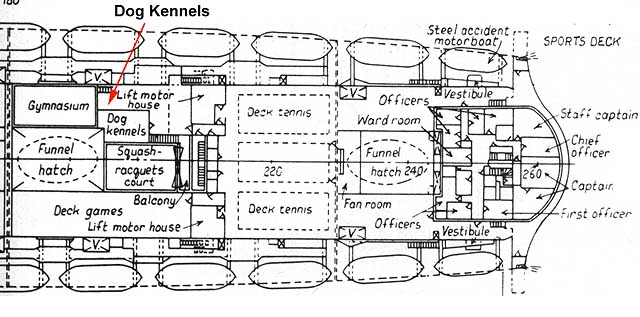
Plan of area
A staircase from the port side of Sun deck led directly up to the kennels, making it
convenient for first class passengers to stop by for a romp with Rover. Bellboys earned
hefty tips for walking dogs throughout a voyage.
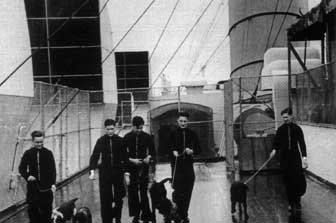
Bellboys walking dogs in the exercise area.
History of Use
1936-1939 - The kennels were used as described above. Two very early
"tenants" were Thor, a German shepherd and Skean, a Scottish terrier belonging
to Charles A. Lindbergh. The Lindbergh family migrated to Britain in late December of
1935, after the "trial of the century" that ended in the conviction and
condemnation of Bruno Hauptman for the kidnapping and murder of their infant son. The dogs
followed in 1936 on the Queen Mary. Lindbergh wrote his mother that, "I am afraid
they have not appreciated the honor."
1940-1946 - The Queen Mary was used as a troop transport.
1947-1967 - The kennels regained their pre-war use as described above.
1968 to present - When the Queen Mary arrived in Long Beach on December 9, 1967 the
kennels were in place and functional. An early consulting study commissioned by the City
of Long Beach prior to its purchase and housed in the archives of the Historical Society
of Long Beach includes a specific recommendation that the kennels be kept in place for
hotel guests' use. Along with the post war first class gymnasium on Sun deck and many
other first class amenities on the upper decks, the study recommended that these amenities
be incorporated into hotel operation.
Very quickly other views dominated thinking in city hall. Rather than preserve the upper
decks of the Queen Mary to provide hotel guests with an ersatz ocean liner experience, Sun
deck and Sports deck were gutted to create a mass tourist attraction. The once elegant
triple tennis courts just forward of the kennels were designated to house "the
world's largest ice cream parlor" (fortunately never built). The gymnasium and cabins
in Sun deck were gutted to house a shopping arcade.
While the deckhouse where the kennels were located survives, the interior was completely
gutted and now serves as an electrical closet.
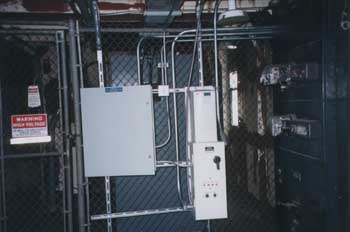
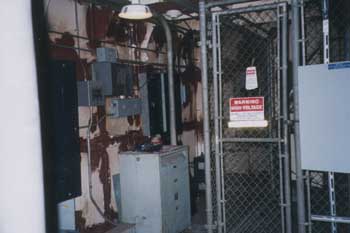
Above - The interior of the kennels today.
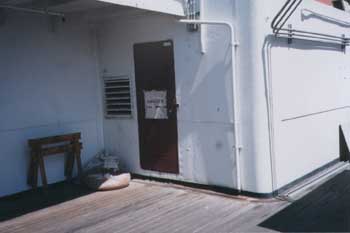
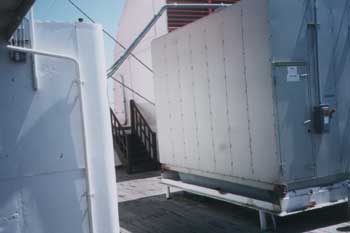
The door to the Kennels as it looks today, and right, air
conditioning equipment nearby.
Sadly, adjacent and directly aft of the
kennels is the empty interior of the mocked-up second funnel. With the slightest effort
and forethought it could easily have been designed to house both the electrical closet and
the myriad of air conditioning equipment now scattered all over the kennel exercise
area (see photo left).
The decision to gut many of the most interesting features on the great ocean liner at
great expense and to turn a fabulous world class icon into an ordinary mass "tourist
attraction" is one of the most intriguing and tragic aspects of the history of the
Queen Mary. It is clear from surviving documentation in local archives and libraries that
this approach was developed only after the ship came to Long Beach. It was not
the recommendation of the professional consultants that were hired to evaluate usage of
the ship before it was purchased by the city.
John Mansell, the city manager at the time, spearheaded the Queen Mary acquisition and
conversion project. As a long time local resident said recently, the Queen Mary was
"Mansell's project." If present day decision making is any clue to the past, the
approach finally adopted by city was most likely developed by one or more of Mansell's
most highly trusted and relied upon staff. The attitude of the initial master lessee,
Diner's Club, the role of local contractors eager for conversion bid works, and the
identity and motivations of the individual(s) on Mansell's staff that played key role(s)
in the "conversion" of the Queen Mary remain to be identified by future
historians.
Potential for restoration and re-use
Assuming a new approach to the attraction and operation of the Queen Mary, the kennels
might again see the light of day. If the hotel were upgraded it is conceivable that the
kennel facility might be of interest to hotel guests for their pets. This certainly would
be a novel amenity! If such a use is not cost-justified then the kennels could still play
a key role in totally reshaping the tourist attraction.
At present the tourist attraction is composed of a series of stationary, unmanned
"exhibits" called the "ship walk". In addition there is a single
guided tour route that is a simplified version of one put in place twenty-five years ago.
One of the benefits of the ship walk to the operator is that it is largely unmanned and
hence labor-efficient. (Has anybody ever heard of volunteer docents?)
A disappointing feature of these "historical" exhibits on the ship walk is that
while they are made up of original objects and are housed in the last surviving ocean
liner of its class, they are displayed department store-window style in areas unrelated to
their origin.
- When you visit the Queen Mary you don't get to see the first class gymnasium in place;
it has been incorporated into a pizza parlour as a seating area ; you only see an exhibit
about the first class gymnasium.
- You don't get to see the first class children's playroom; it is used to sell coffee, tea
and candy; you see an exhibit about the first class playroom one deck up.
- You don't get to see the synagogue even though it is right on the path of the single
guided tour and is unused. You see an exhibit about the synagogue four decks up and
right next to a display about the surgical operating room.
The exceptions to this rule are the wheelhouse and the aft engine room/steering area
display – but only when it is not closed down and incorporated into the annual
Halloween haunt that is now extended through the entire month of October and called
evocatively "Decks of the Dead." Even the navigation officer's quarters are
partially gutted and displayed in a department store window style – "to
facilitate circulation."
It is quite easy to conceive of a multi-tour program that shows off more of the ship,
extends the length and number of tourists' visits, generates more revenue for the ship,
and has no greater impact on the hotel and catering option than the current approach.
While their routes and focus are open to discussion, it would still be useful to have a
ship walk for viewing between the paid guided tours.
If we are going to have a ship walk, or self-guided intra-tour feature, why not one
composed of original features to be seen, used and enjoyed in their original setting? In
this context the kennels again become a useful business feature for the attraction.
- How about a knowledgeable trained volunteer docent that has done his or her homework and
can answer questions and give an interesting presentation?
- Perhaps a few of the empty cages might contain well - designed souvenirs for your Rover
– like QM dog biscuits or leather leash and collar?





